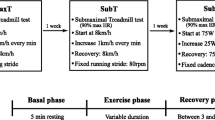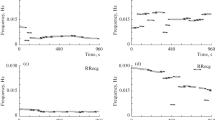Summary
The methodology of using frequency analysis in order to identify types of system(s) is discussed. A number of models with their characteristic Nyquist plots are presented graphically, to facilitate the identification of various types of systems by pattern recognition. A small series of measurements of oxygen consumption and heart rate has been carried out to illustrate the possibilities and limitations of the use of frequency analysis in exercise physiology. With a step function method one can only establish whether a system has multiple components in parallel or not, but with the frequency analysis method one can identify whether a system has multiple components in parallel or in series. It was found that under moderate exercise, the response of oxygen consumption to exercise is a system with multiple components in series, but the response of heart rate to exercise is a system with multiple components in parallel. The data that were obtained are in agreement with those produced by other authors, but the curves to fit the observed data were obtained using second order linear transfer functions.
Similar content being viewed by others
References
Agnew RP (1960) Differential equations. McGraw-Hill, New York
Asmussen, E (1946) Aerobic recovery after anaerobiosis in rest and work. Acta Physiol Scand 11: 197–210
Astrand P-O, Ryhming I (1954) A nomogram for calculation of aerobic capacity (physical fitness) from pulse rate during submaximal work. J Appl Physiol 7: 218–221
Bowen WP (1904) Changes in HR, blood pressure and duration of systole resulting from bicycling. Am J Physiol 11: 59–77
Casaburi R, Whipp BJ, Wasserman K, Bearer WL, Koyal SN (1977) Ventilatory and gas exchange dynamics in response to sinusoidal work. J Appl Physiol 42(2): 300–311
Christensen EH (1931) BeitrÄge zur Physiologie schwerer körperlicher Arbeit. V. Minutenvolumen und Schlagvolumen des Herzens wÄhrend schwerer körperlicher Arbeit. Arbeitsphysiol 4: 470–502
Daubenspeck JA (1973) Frequency analysis of CO2 regulation: Afferent influences on tidal volume control. J Appl Physiol 35: 662–672
Henry FM, de Moore JC (1956) Lactic and alactic oxygen consumption in moderate exercise of graded intensity. J Appl Physiol 8: 608–614
Krogh A, Lindhard J (1913) The regulation of respiration and circulation during the initial stages of muscular work. J Physiol (Lond) 47: 112–136
Lanooy C, Bonjer FH (1956) A hyperbolic ergometer for cycling and cranking. J Appl Physiol 9(3): 499–500
McFarland DJ, Budgell PW (1970) Determination of a behavioural transfer function by frequency analysis. Nature 226: 966–967
Milsum JH (1966) Biological control system analysis. McGraw-Hill, New York
Ryder JD (1973) Introduction to circuit analysis. Prentice-Hall, Englewood Cliffs, NJ
Stark L, Sherman PM (1957) A servoanalytic study of consensual pupil reflex to light. J Neurophysiol 20: 17–26
Thorson J (1964) Dynamics of motion perception in the desert locust. Science 145: 69–71
Wigertz O (1970) Dynamics of ventilation and heart rate in response to sinusoidal work load in man. J Appl Physiol 29: 208–218
Author information
Authors and Affiliations
Rights and permissions
About this article
Cite this article
Chang, K.S., Snellen, J.W. The use of sinusoidally changing workloads as an aid to identify dynamic properties of physiological systems. Europ. J. Appl. Physiol. 49, 97–109 (1982). https://doi.org/10.1007/BF00428968
Accepted:
Issue Date:
DOI: https://doi.org/10.1007/BF00428968




